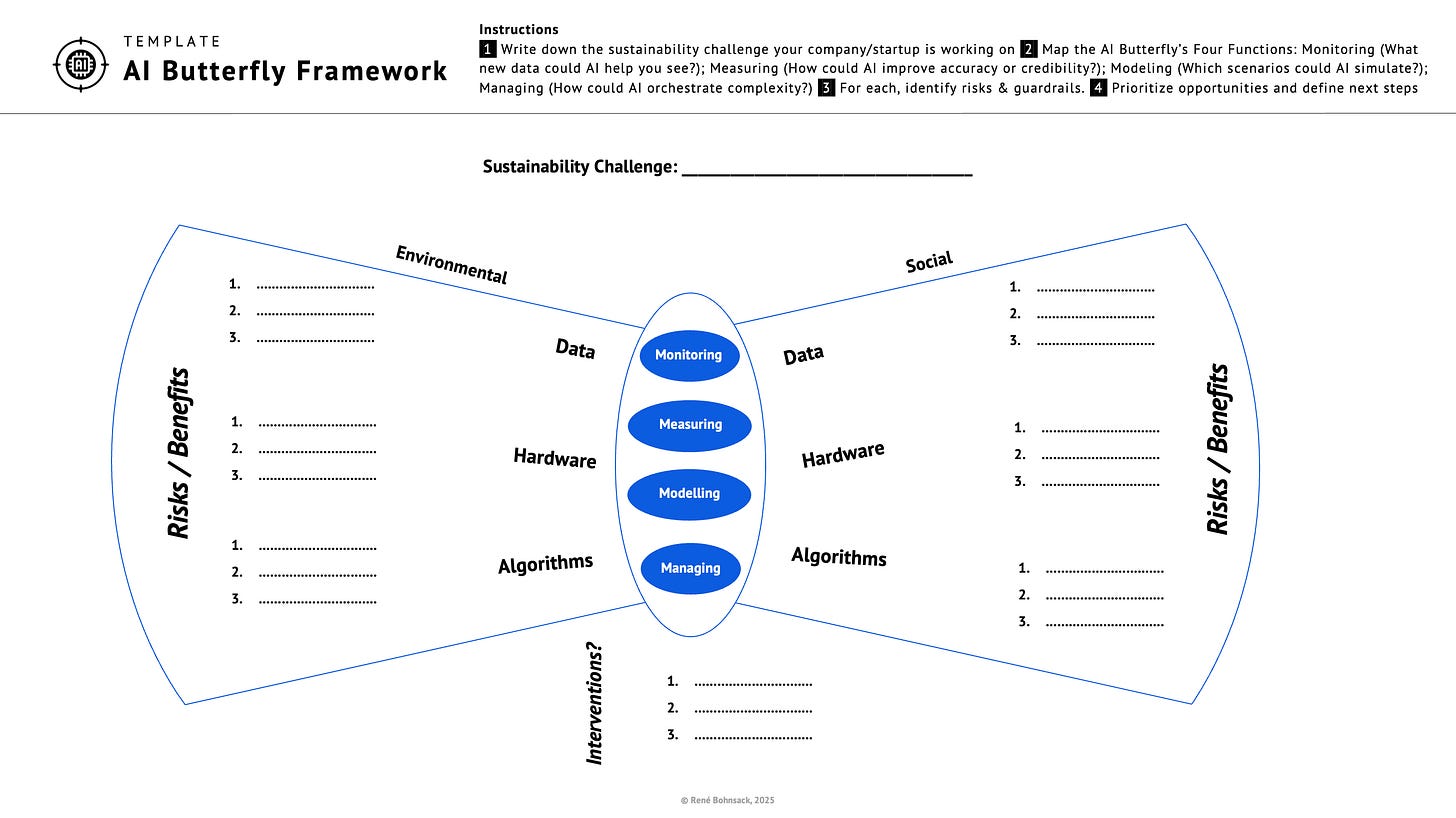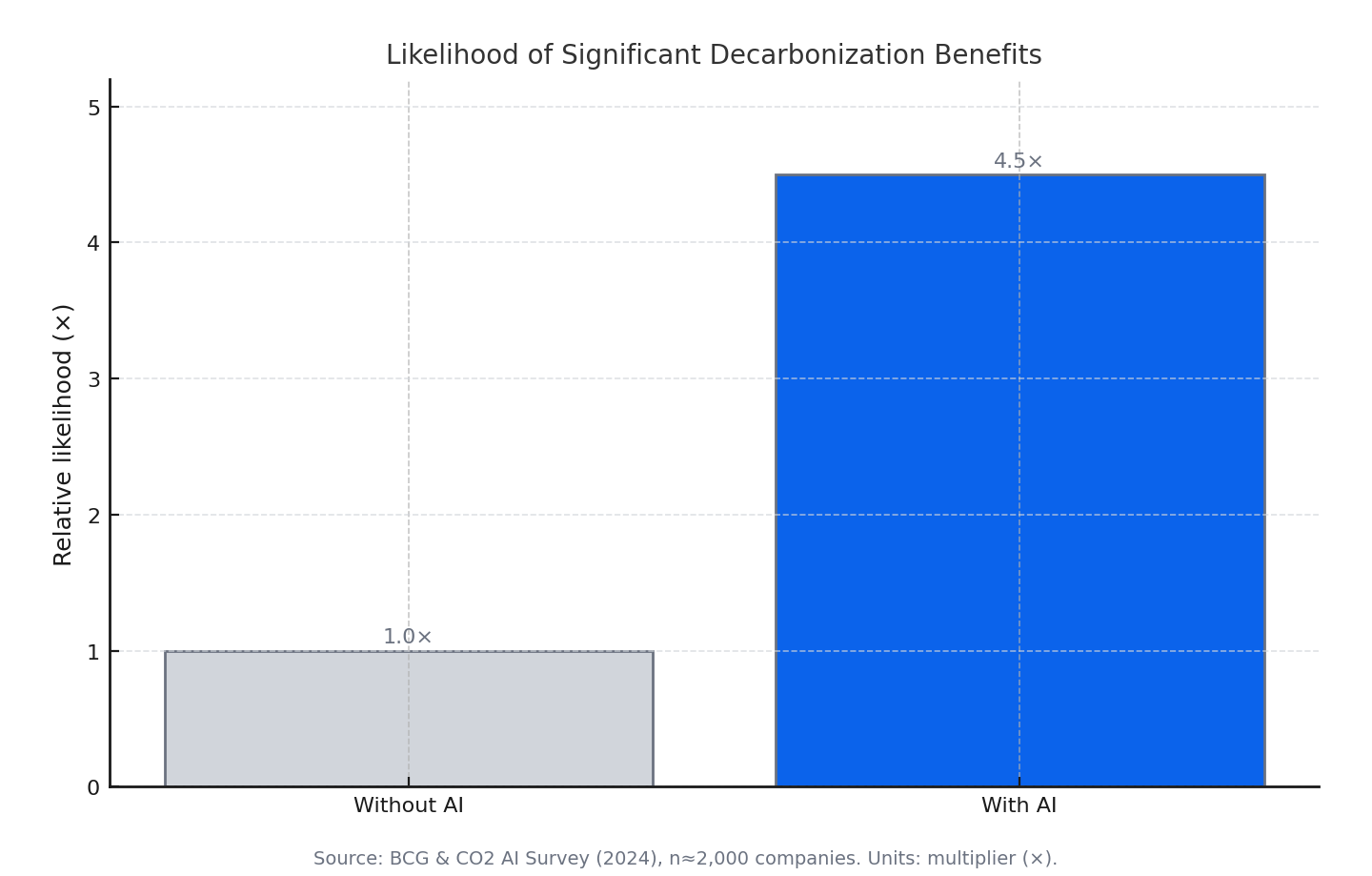Harnessing AI for Climate Innovation
Lessons from ClimaTech Connect 2025
TL;DR
At ClimaTech Connect’s workshop, an EU-backed acceleration program co-designed and co-delivered by Climate KIC and EIT Digital, we explored how AI can help climate startups accelerate their innovation journey.
Despite a ~40% drop in global climate tech investment in 2024, AI-enabled ventures grew nearly 9%, raising $6B and showing resilience.
To capture this opportunity while managing risks, leaders can apply the AI Butterfly Framework (Monitoring, Measuring, Modeling, Managing).
The future of climate innovation will be shaped not just by hardware breakthroughs but by system-level intelligence orchestration.
About ClimaTech Connect
ClimaTech Connect is an EU-backed program designed to accelerate the growth of climate tech startups through mentoring, workshops, and investor connections. It brings together founders tackling everything from renewable integration and circular economy solutions to AI-powered carbon tracking. The program’s mission is simple but ambitious: help ventures scale faster and contribute to Europe’s climate neutrality goals.
This year’s participants were diverse, spanning circular platforms, renewable energy projects, data-driven optimization, and sustainable materials. What united them was a sense of urgency: climate solutions cannot wait.
Climate Innovation Meets AI
The climate innovation ecosystem has matured rapidly. Startups and corporates alike are working on solutions for two pressing challenges:
Hard-to-decarbonize sectors like steel, cement, and aviation, where low-carbon alternatives are still niche.
Hard-to-deploy sectors like EVs, heat pumps, and retrofits, where adoption is slow despite proven technologies.
Against this backdrop, AI has emerged as both a differentiator and a scaling mechanism. Unlike past digital shifts, AI is not just a tool, it is becoming an engine of transformation across the entire climate value chain.
Funding Dynamics: A Tale of Two Trends
Recent figures reveal a paradox. In 2024, global climate tech investment dropped from $84B to $51B, marking a 40% contraction. Yet, AI-enabled climate ventures defied this downturn, growing nearly 8.77% and raising $6B, exceeding the entire 2023 total.
This divergence underscores a critical insight: capital is increasingly flowing toward ventures where AI is not an afterthought but central to the value proposition.
AI’s potential to accelerate climate action is becoming increasingly clear. From optimizing energy systems and circular economies to improving forecasting and measurement accuracy, AI has the capacity to reshape how sustainability is achieved at scale.
The biggest opportunities are concentrated in three domains:
Energy: Smarter grid management and renewables optimization (–1.8 GtCO₂e/year).
Food and Agriculture: Precision farming and alternative proteins (–3 GtCO₂e/year).
Mobility: Route optimization and logistics efficiency (–0.6 GtCO₂e/year).
AI does not solve climate challenges alone, but it accelerates what is already possible and creates new pathways that were previously invisible.
The AI Butterfly: Harnessing Intelligence, Managing Risks
In our research, Jonatan Pinkse and I developed the AI Butterfly Effect Framework, published in Amplify. The idea is simple but powerful: AI is like a butterfly, small interventions can create outsized impacts, both positive and negative.
The framework identifies four key functions where AI drives sustainability:
Monitoring – Expanding visibility into biodiversity, deforestation, and supply chains.
Measuring – Increasing accuracy of carbon accounting, especially Scope 3 emissions.
Modeling – Forecasting net-zero pathways and identifying optimal solutions.
Managing – Orchestrating complexity, from grid balancing to circular economy flows.
But here’s the paradox: these same functions can generate risks. AI can overestimate adoption curves, lock in biased data, or optimize for efficiency at the expense of true sustainability. Leaders must therefore design guardrails to ensure AI accelerates solutions rather than creating new externalities.
Corporate Adoption: From Pilots to Performance
The corporate world is catching up fast. A global survey of over 2,000 companies (CO2 AI, 2024) found that organizations using AI are 4.5x more likely to achieve meaningful decarbonization outcomes.
These are not marginal gains. They are systemic shifts in productivity, emissions reduction, and competitiveness.
The Double-Edged Reality
AI’s environmental benefits are clear, but its footprint cannot be ignored. Data center electricity consumption has been growing at 12% annually, four times faster than global averages. By 2030, AI-related emissions could climb to 718 million tonnes CO2e.
The net effect remains positive. Studies suggest AI’s climate benefits outweigh its footprint by a factor of 5–8x, but only if its deployment is targeted at high-leverage areas like renewables, mobility, and circular systems.
Looking Ahead
Climate innovation is moving into a new phase. Hardware solutions, from solar panels to heat pumps, remain essential. But the differentiator will increasingly be how intelligently these technologies are integrated, managed, and scaled.
Perhaps the most profound shift of 2025 is the rise of agentic AI systems, autonomous agents capable of perceiving, deciding, and acting. In climate tech, this could mean:
Negotiating renewable energy contracts in real time.
Dynamically managing grid loads across regions.
Optimizing carbon markets with minimal human input.
This evolution takes AI from being a productivity tool to becoming an orchestrator of climate systems.
Final Reflection
Europe’s ClimaTech Connect program is just one example of ecosystems helping startups align with this reality. Across continents, we are seeing a common pattern: the future winners will not be those who simply build new solutions, but those who orchestrate intelligence to make them systemic. By 2030, the world needs $2 trillion in climate tech investments annually. AI isn’t just another tool in this equation, it’s the scaling mechanism that can turn promising innovations into systemic change.
The climate race is not just about building more, it’s about building smarter. AI gives us the chance to reimagine business models, accelerate adoption curves, and unlock systemic efficiency. But without careful design, it risks creating new externalities as fast as it solves old ones.
The lesson is clear: Don’t just ask, “How can we use AI?” Ask instead, “Which climate problem must we solve, and how can AI help us solve it faster, better, and more credibly?”
The next decade of climate innovation will not be defined by isolated breakthroughs. It will be defined by how well we orchestrate intelligence, across data, systems, and societies, to achieve net zero.




